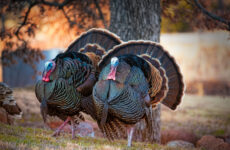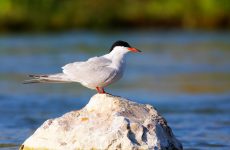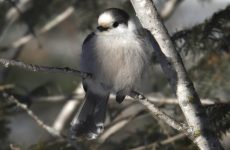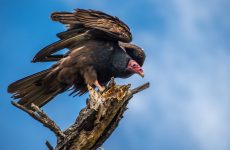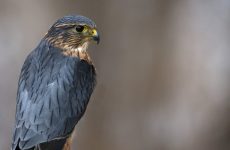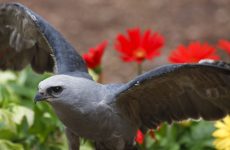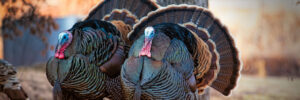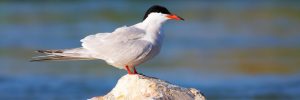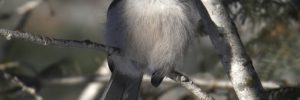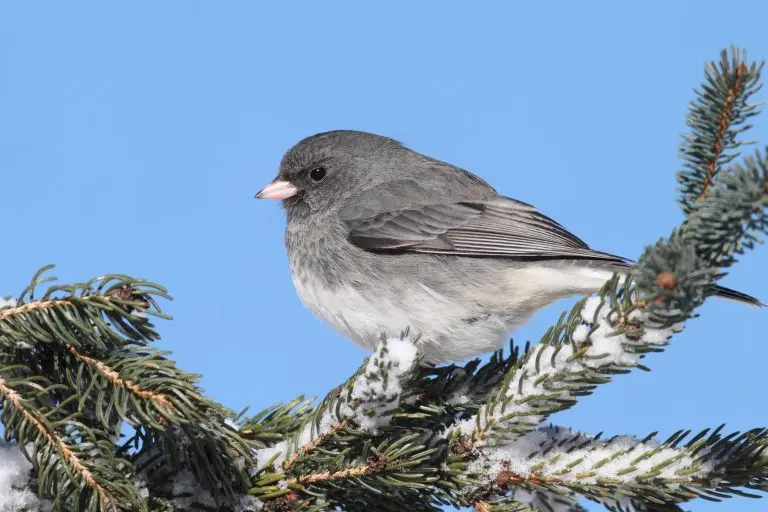
Although Ontario gets very cold in winter there are still many birds that remain during these cold months including many ducks, finches such as Common Redpoll and Evening Grosbeak and woodpeckers such as Downy and Hairy Woodpeckers and not forgetting Chickadees, Juncos, crows and Jays and the bright red Northern Cardinal.
Winter is a great time to go bird spotting or to hang a feeder and watch from the comfort of your home as you can spot birds more easily in the bare trees and birds will readily come to feeders for a source of food when it is scarce elsewhere.
Check out this guide to backyard birds in Ontario to get a free printable of birds that visit throughout the year so you have a quick and easy printed photo ID guide.
25 Common Winter Birds Ontario
1. Black-capped Chickadee
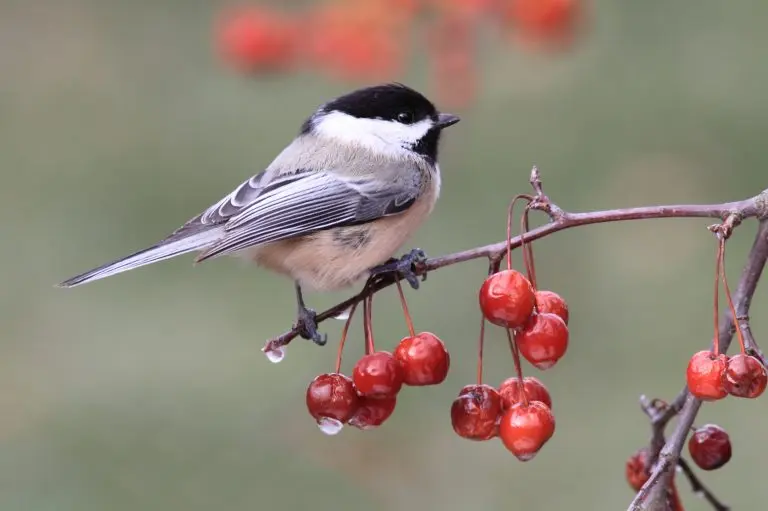
The Black-capped Chickadee is a cute bird with a big round head and tiny body. These birds will happily feed at backyard feeders and investigate everything, including you!
They have black caps and beaks, white cheeks, and are gray on the back, wings, and tail.
- Poecile atricapillus
- Length: 4.7-5.9 in (12-15 cm)
- Weight: 0.3-0.5 oz (9-14 g)
- Wingspan: 6.3-8.3 in (16-21 cm)
Black-capped Chickadees do not migrate and can be spotted in the northern half of the US and Canada.
You can find them in forests, open woods, and parks. Black-capped Chickadees eat seeds, berries and insects, spiders, and suet.
Black-capped Chickadee Call/Song:
Attract Black-capped Chickadees to your backyard with suet, sunflower seeds, and peanuts or peanut butter. They will even feed from your hand and are often one of the first birds to discover new feeders. They will also use nest boxes, especially if you fill them with wood shavings.
2. Dark-eyed Junco

Dark-eyed Juncos are sparrows that are different colors depending on the state. They are generally slate-colored in the east and black, white, and brown in the west.
- Junco hyemalis
- Length: 5.5-6.3 in (14-16 cm)
- Weight: 0.6-1.1 oz (18-30 g)
- Wingspan: 7.1-9.8 in (18-25 cm)
Dark-eyed Juncos remain resident all year in northeastern and western US states and the Appalachian Mountains. Those that breed in Canada and Alaska migrate south in winter to the United States.
They can be found in open and partially wooded areas, often on the ground, and are common across the continent.
Dark-eyed Junco Song:
Attract Dark-eyed Juncos to backyard feeders with a variety of seeds such as black oil sunflower seeds, nyjer, cracked corn, millet, and peanuts. Platform feeders or scattered on the ground are best.
3. Blue Jay
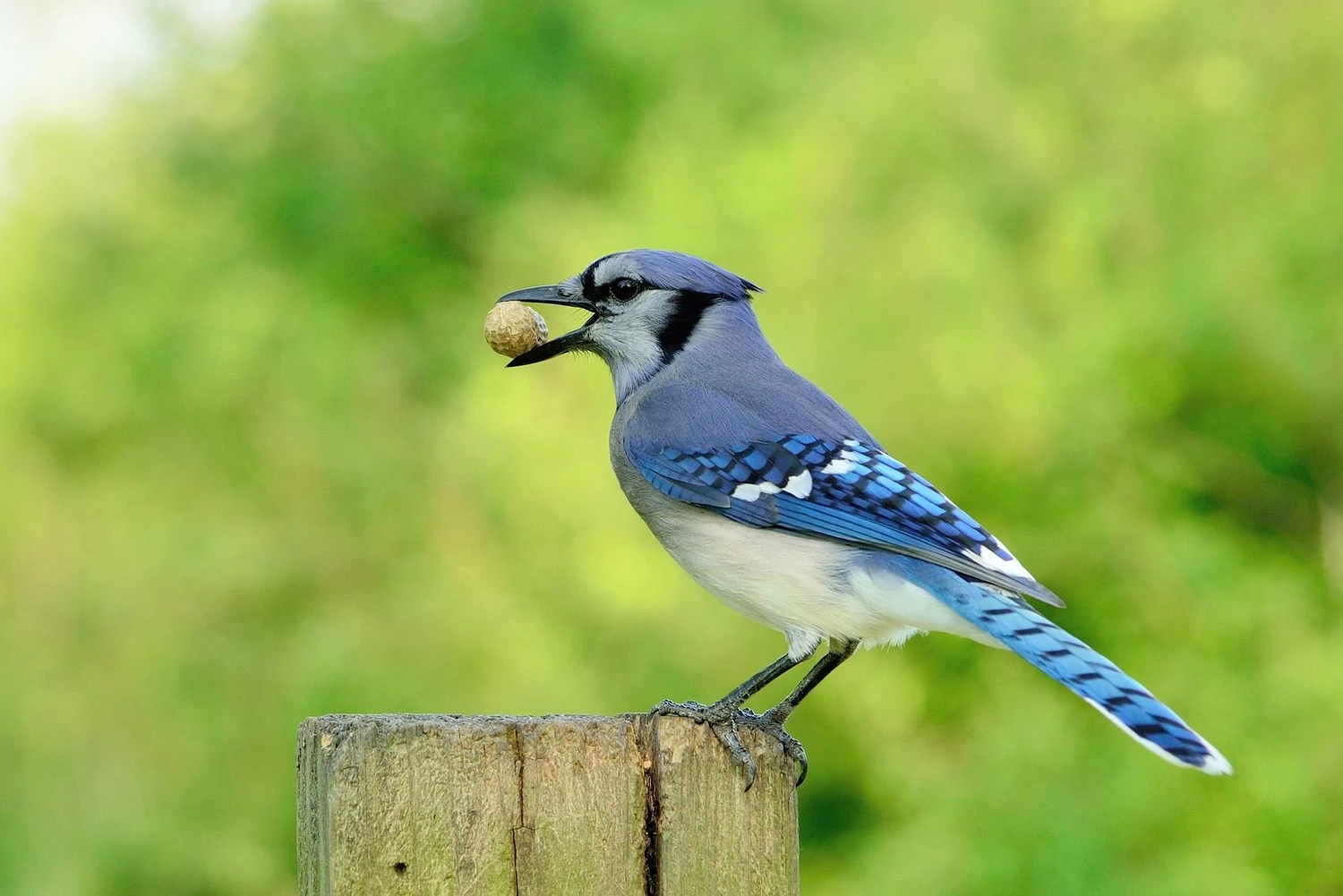
Blue Jays are common large songbirds with a blue upright crest, blue and black backs, and white undersides.
- Cyanocitta cristata
- Length: 9.8-11.8 in (25-30 cm)
- Weight: 2.5-3.5 oz (70-100 g)
- Wingspan: 13.4-16.9 in (34-43 cm)
Blue Jays live in eastern US states and Southern Canada all year. Some birds will migrate west for winter but not very frequently.
They are noisy birds that travel in family groups eating acorns when available. They can be found in forests, mainly near oak, as they eat acorns. They can also be found in backyards near feeders. As well as acorns, they eat insects, nuts and seeds, and grain. They may also take eggs from nests or take nestlings.
Blue Jay Call:
Blue Jays are large birds and prefer to fly in, grab a peanut or sunflower seed and take it away to feed. They prefer platform or tray feeders to make it easy to make a quick exit.
Attract Blue Jays to your backyard with peanuts, sunflower seeds, and suet. They prefer these on open tray feeders or hopper feeders on a post. They will also enjoy a birdbath.
4. American Crow
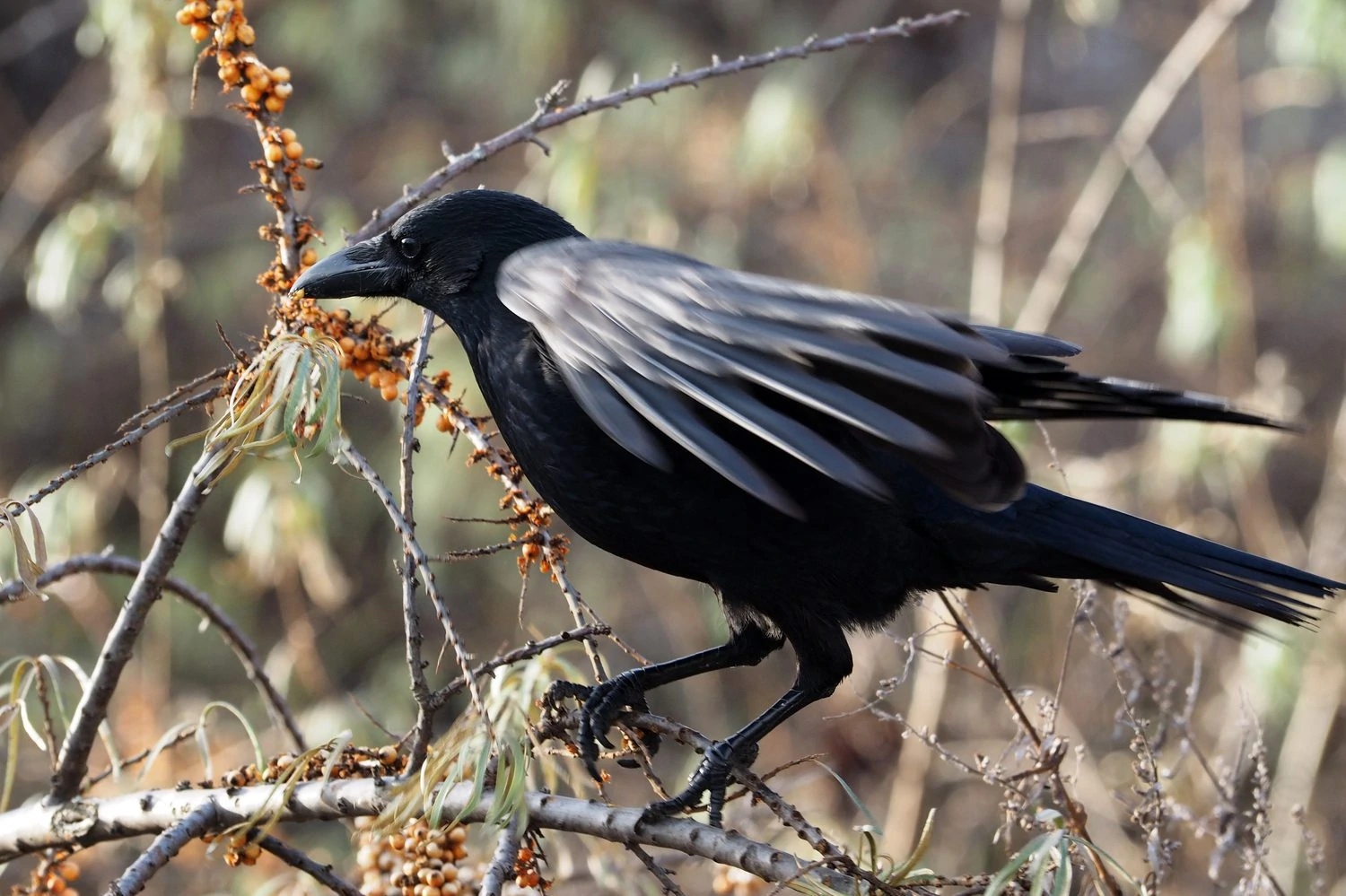
American crows are large all-black birds that make a hoarse, cawing sound.
- Corvus brachyrhynchos
- Length: 15.8-20.9 in (40-53 cm)
- Weight: 11.2-21.9 oz (316-620 g)
- Wingspan: 33.5-39.4 in (85-100 cm)
American Crows are residents all year in most of the lower 48 and the Pacific Coast in Canada and Alaska. Those that breed in Canada and the northern Midwest migrate south for winter.
They are common birds found in most habitats, including treetops, woods, fields, beaches, or towns.
They eat most things and usually feed on the ground, eating earthworms, insects, seeds, and fruit. They also eat fish, young turtles, mussels, and clams and will even eat eggs and nestlings of many species of birds.
In winter, American Crows gather in large numbers of up to two million crows to sleep in noisy communal roosts.
American Crow Call:
Attract American Crows to your backyard by scattering peanuts, but they can become a nuisance as they are attracted by garbage or pet food if left out.
5. Northern Cardinal
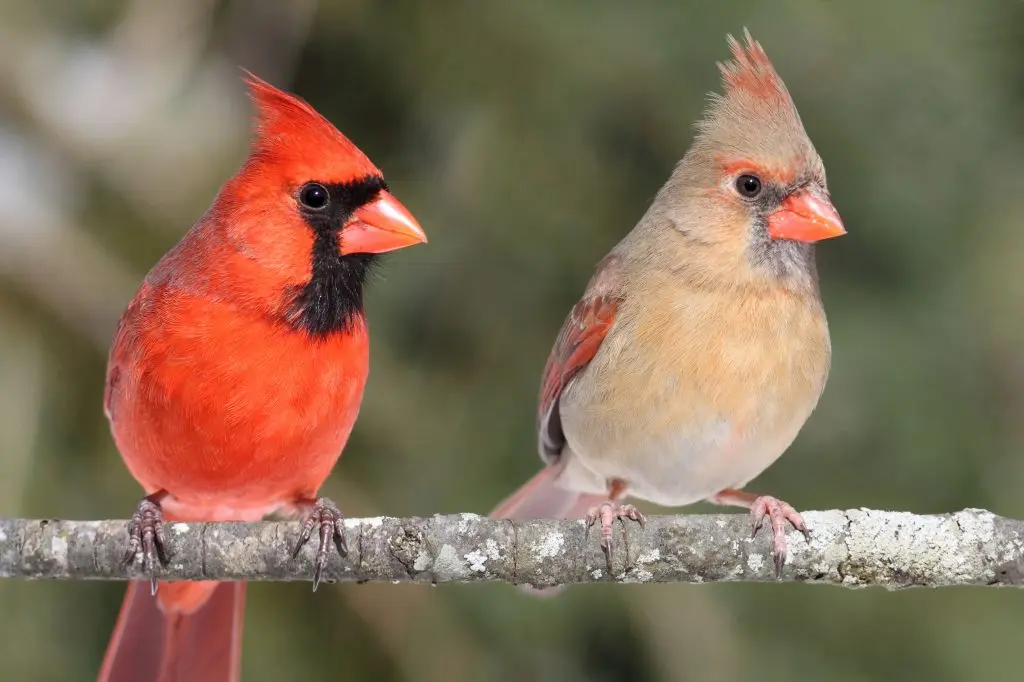
The bright red male Northern Cardinal with black around their faces is an incredible sight, especially against a white winter background. They also have red crests and beaks.
Females are also a little showy with their brown coloring, sharp brown crest, red highlights, and red beaks.
- Cardinalis cardinalis
- Length: 8.3-9.1 in (21-23 cm)
- Weight: 1.5-1.7 oz (42-48 g)
- Wingspan: 9.8-12.2 in (25-31 cm)
Northern Cardinals live in the Eastern half of the US and some states in the south as far west as Arizona.
You can find Northern Cardinals in dense vegetation foraging for seeds, fruit, and insects. Northern Cardinals will sometimes attack their own reflection during the breeding season as they obsessively defend their territories.
Northern Cardinal Song:
Northern Cardinal Call:
Attract Northern Cardinals to your backyard with feeders full of sunflower seeds, peanut hearts, millet, and milo. They will feed from large tube feeders, hoppers, platform feeders, or food scattered on the ground.
6. Downy Woodpecker
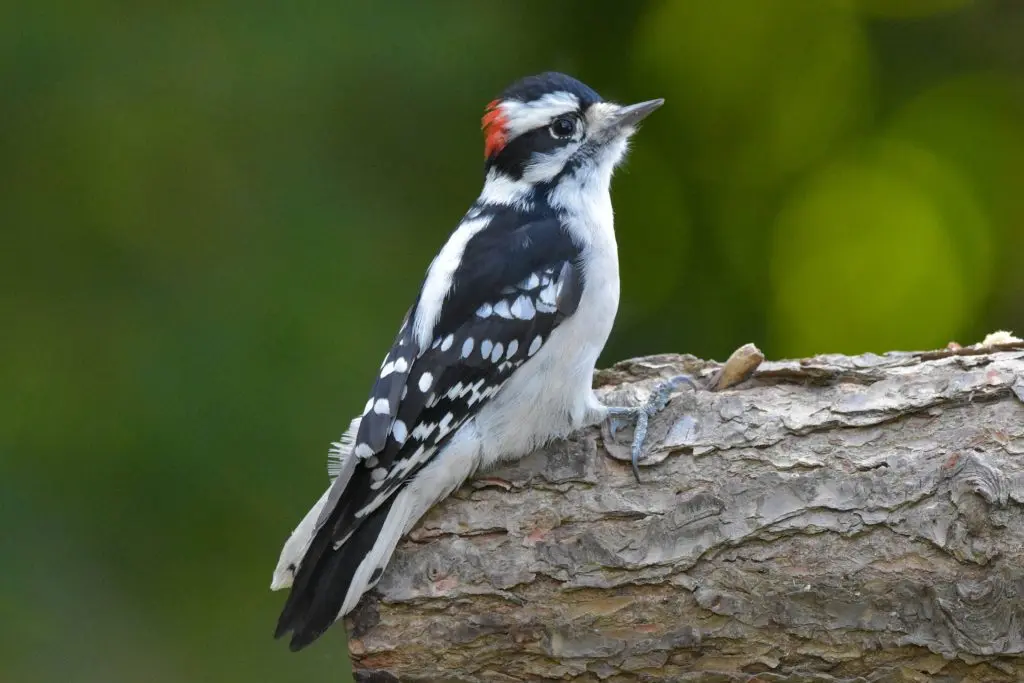
Downy Woodpeckers are small birds that are common at backyard feeders. They are often mixed in with other birds, such as chickadees and nuthatches.
They have black and white coloring with a red patch at the back of their heads. They look similar to the Hairy Woodpecker but smaller.
- Dryobates pubescens
- Length: 5.5-6.7 in (14-17 cm)
- Weight: 0.7-1.0 oz (21-28 g)
- Wingspan: 9.8-11.8 in (25-30 cm)
Downy Woodpeckers do not migrate and can be spotted in most states and provinces, except the north of Canada.
You can find Downy woodpeckers in woodlots, along streams, city parks, and backyards, and they eat mainly insects and beetle larvae but also berries, acorns, and grains.
Downy Woodpecker Call:
Attract Downy Woodpeckers to your backyard with their favorite treat of suet, but they will also eat black oil sunflower seeds, millet, and peanuts on platform feeders.
7. American Goldfinch
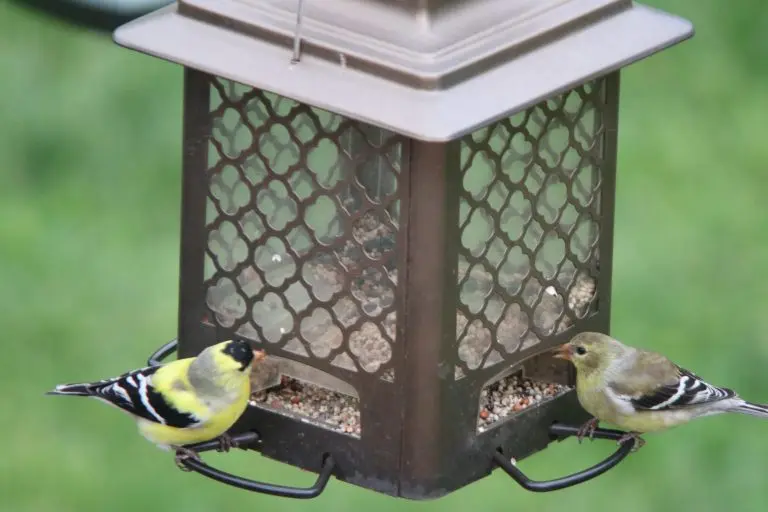
American Goldfinches are popular birds with the males’ bright yellow and black coloring in spring. The females are duller brown, as are males in winter.
- Spinus tristis
- Length: 4.3-5.1 in (11-13 cm)
- Weight: 0.4-0.7 oz (11-20 g)
- Wingspan: 7.5-8.7 in (19-22 cm)
American Goldfinches can be found in most of North America and are usually resident all year. However, those that breed in Canada and the Midwest migrate to southern US States for winter.
They can be found in weedy fields and overgrown areas foraging for sunflower, thistle, and aster plants. They are also common in suburbs, parks, and backyards.
American Goldfinch Song:
Attract American Goldfinches to your backyard by planting thistles and milkweed. They will visit most bird feeders and prefer sunflower seed and nyjer seed.
8. Mourning Dove
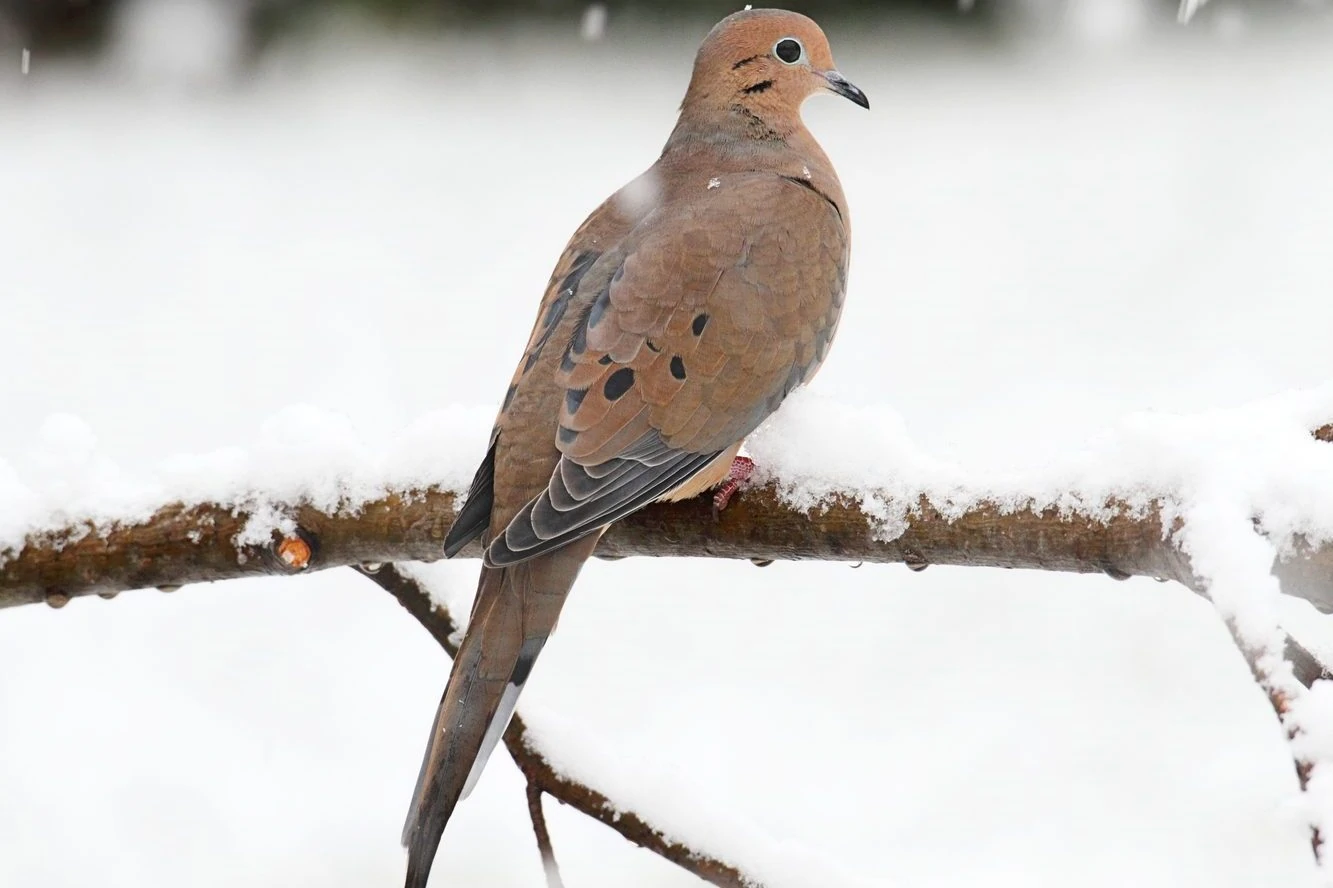
Mourning Doves are graceful small-headed birds with plump bodies and long tails. They are a soft brown color with black spots on the wings. Males are slightly heavier than females.
- Zenaida macroura
- Length: 9.1-13.4 in (23-34 cm)
- Weight: 3.0 -6.0 oz (96-170 g)
- Wingspan: 17.7 in (45 cm)
Mourning Doves are common over all of the lower 48 all year but may migrate after breeding from the north of the Midwest and southern Canada.
Mourning Doves can be seen perching on telephone wires and foraging for seeds on the ground in grasslands, fields, and backyards. They can also be found in open areas or woodland edges.
Mourning Dove call:
Attract Mourning Doves to your backyard by scattering millet on the ground or platform feeders. They will also eat black sunflower seeds, nyjer, cracked corn, and peanut hearts.
9. White-breasted Nuthatch
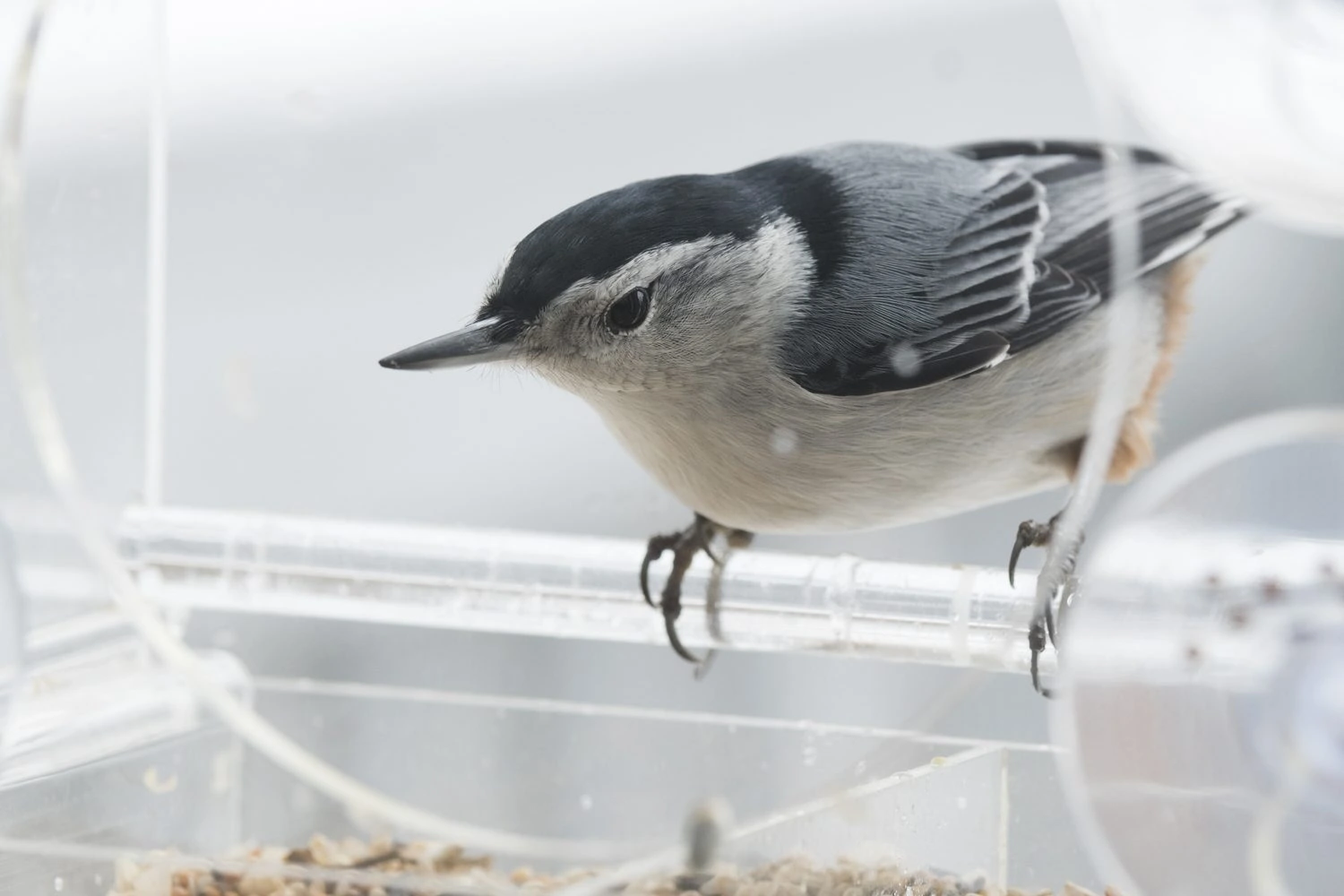
White-breasted Nuthatches are active little birds that are gray-blue on the back and white on the face and belly, with a black cap. They will often have a chestnut color on the lower belly and under the tail.
- Sitta carolinensis
- Length: 5.1-5.5 in (13-14 cm)
- Weight: 0.6-1.1 oz (18-30 g)
- Wingspan: 7.9-10.6 in (20-27 cm)
White-breasted Nuthatches live all year in the US and southern Canada.
You can find White-breasted Nuthatches in deciduous forests, woodland edges, parks, and yards with trees or at feeders. They mainly eat insects, including beetles and their larvae, caterpillars, ants, and also spiders.
White-breasted Nuthatches also eat seeds and nuts, including acorns, hawthorns, sunflower seeds, and sometimes corn crops. They jam large nuts and acorns into tree bark and then whack them with their bills to open or ‘hatch’ them to get the seed out.
White-breasted Nutcracker Call:
Attract White-breasted Nuthatches to your backyard with sunflower seeds and peanuts on tube feeders or suet feeders.
10. Canada Goose
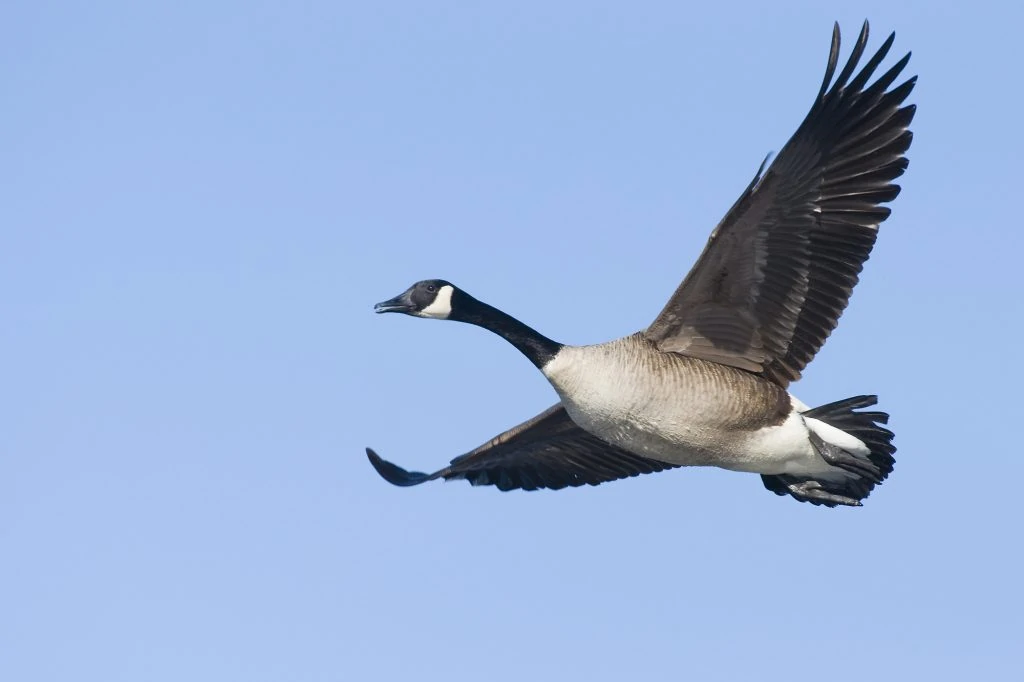
The Canada Goose, also called the Canadian goose, is a large, long-necked goose recognized for its black head and easily identifiable white chin strap.
Canada Geese look very similar to Cackling Geese, and they have the same black head and white chin strap, but their long, graceful neck and large size separate them.
Their bodies are brown with a tan or pale chest and white rump. The color of the bodies among the subspecies may be shades of gray or brown. Their legs and webbed feet are black.
- Branta canadensis
- Length: 25 – 45 in (64 – 114 cm)
- Weight: 230.09 oz (6521 g)
- Wingspan: 70 – 75 in (178 – 190 cm)
As their name would suggest, Canada Geese breed in Canada and migrate for the winter to southern US states, but those in northern US states remain all year and do not migrate. They are also found in western Europe.
You can find Canada Geese practically anywhere. They are often seen near lakes and rivers, basically, anywhere there’s a body of water and an abundant food source. They are also used to humans, so they live comfortably in urban habitats like city parks, reservoirs, golf courses, public parks, and beaches.
In some places, their population has risen considerably and they’re considered pests.
Canada Geese mainly eat grasses when they’re on land and small aquatic insects and fish when they’re on the water. They also eat wheat, rice, and corn when they’re on agricultural fields. They’re accustomed to receiving food from humans or digging through trash cans.
Canada Goose Call:
Fun Fact: During the breeding season, adults lose their flight feathers because it coincides with their molting season. They only regain their feathers after twenty to forty days, just in time for them to fly with their young.
11. Mallard
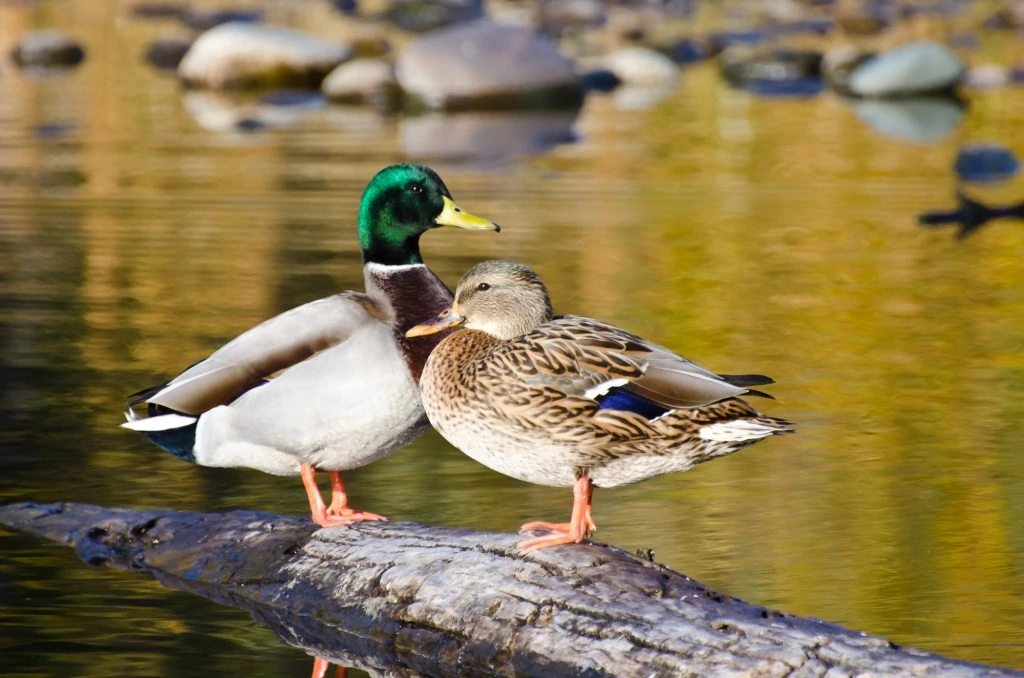
Mallards are large ducks, and the males have striking green heads. They also have bright yellow bills and gray bodies with brown breasts and black towards the tail. They have a curl of tail feathers and a blue patch on the wings bordered with white which is called a speculum.
Females and juveniles are mottled brown with orange bills but still have the blue speculum.
- Anas platyrhynchos
- Length: 19.7 – 25.6 in (50 – 65 cm)
- Weight: 35.3 – 45.9 oz (1000 – 1300 g)
- Wingspan: 32.3 – 37.4 in (82 – 95 cm)
Mallards remain all year in most of the lower 48 and the western coast of Canada and Alaska. Those that breed in Canada and Alaska head south to the southern United States and northern Mexico.
Mallards are one of the most commonly spotted and recognizable ducks that will happily be fed on ponds and rivers. They are dabbling ducks that feed on water plants and do not dive. They are very long-lived, and they have been recorded at 27 years old.
Mallard Calls:
Male Mallards don’t quack, only females do. Instead, the male makes a rasping sound.
Male Mallard Call
Female Mallard Call
Fun Fact: Most domesticated ducks are descended from Mallards, and they have been hunted and bred for food.
12. European Starling
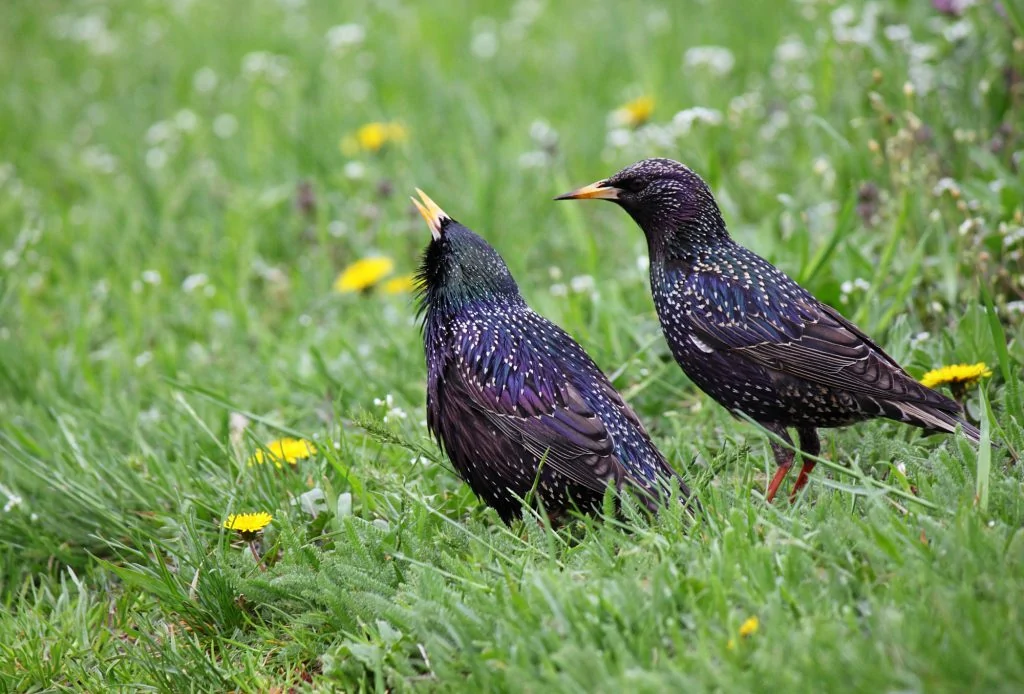
European Starlings are not native but are now one of the most numerous songbirds. They are stocky black birds with iridescent purple, green, and blue tones.
- Sturnus vulgaris
- Length: 7.9-9.1 in (20-23 cm)
- Weight: 2.1-3.4 oz (60-96 g)
- Wingspan: 12.2-15.8 in (31-40 cm)
European Starlings live in all of North America, except the north of Canada and Alaska.
They are considered a pest by some due to their aggressive behavior. These birds fly in large, noisy flocks and can be seen perched in groups on the top of trees or flying over fields.
European Starling Calls:
Starlings predominantly eat insects, including beetles, flies and caterpillars, earthworms, and spiders. However, they also eat fruit, including cherries, holly berries, mulberries, Virginia Creeper, sumac, blackberries, and grains and seeds.
Attract European Starlings to your backyard feeders with black oil sunflower seeds, suet, cracked corn, and peanuts.
13. House Sparrow
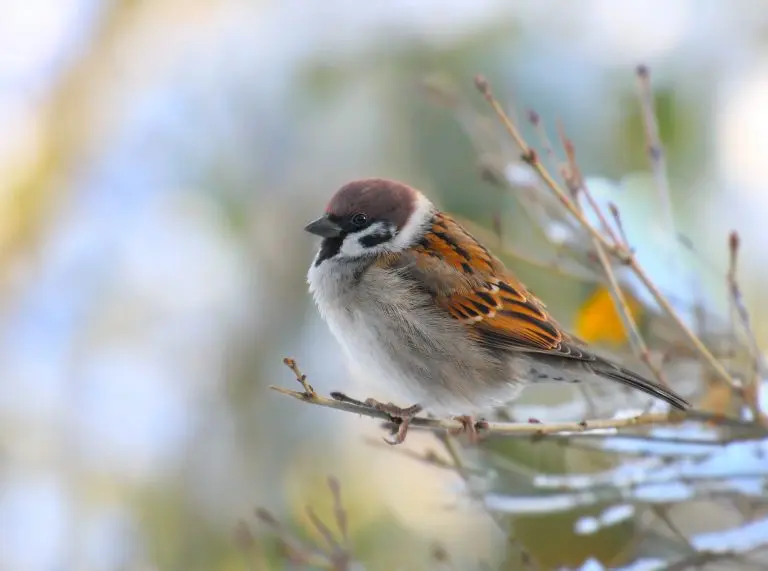
The House Sparrow is another introduced species that has done very well and is now one of the most common birds. They have gray and brown heads and white cheeks. Their backs are black and brown, and their bellies are gray.
- Passer domesticus
- Length: 5.9-6.7 in (15-17 cm)
- Weight: 0.9-1.1 oz (27-30 g)
- Wingspan: 7.5-9.8 in (19-25 cm)
House Sparrows live in the US and Southern Canada all year.
You can find them near houses and buildings, and they can be pretty tame, and they may even eat out of your hand.
House Sparrows eat mostly grain and seed as well as discarded food. They can be considered a pest because they are non-native, but they are found in backyards even if you do not feed them.
House Sparrow Song:
Attract House Sparrows to your backyard feeders with most kinds of birdseed, including millet, corn, and sunflower seeds.
14. Hairy Woodpecker
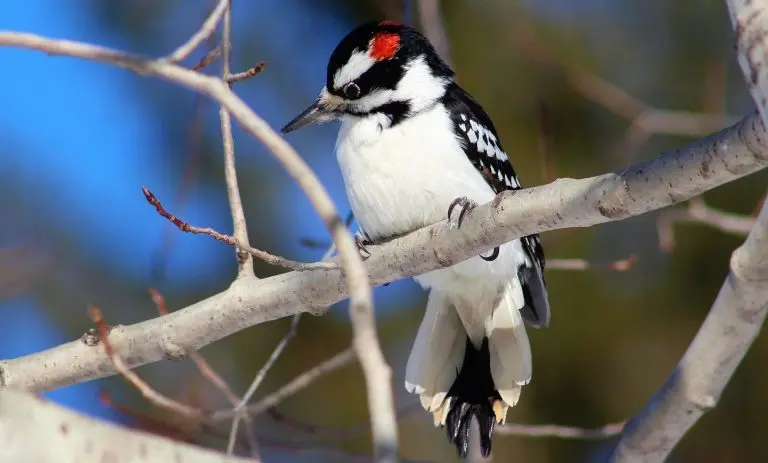
Hairy Woodpeckers are medium-sized woodpeckers with a black and white pattern and a large white patch on their backs. The males have a flash of red towards the back of their heads.
They are visually similar to Downy Woodpeckers but larger and with longer bills. As they are often found in the same areas, it is hard to tell them apart if they are not near each other.
- Dryobates villosus
- Length: 7.1-10.2 in (18-26 cm)
- Weight: 1.4-3.4 oz (40-95 g)
- Wingspan: 13.0-16.1 in (33-41 cm)
Hairy Woodpeckers do not migrate and live in all US states and Canada, except the far north of Canada.
You can find Hairy Woodpeckers in woodlands on trunks or main branches of large trees, but they are also found in a wide variety of habitats, including woodlots, parks, and cemeteries. Hairy Woodpeckers’ diet is mostly insects.
Hairy Woodpecker Call/drumming:
Attract Hairy Woodpeckers to your backyard with suet feeders.
15. American Tree Sparrow
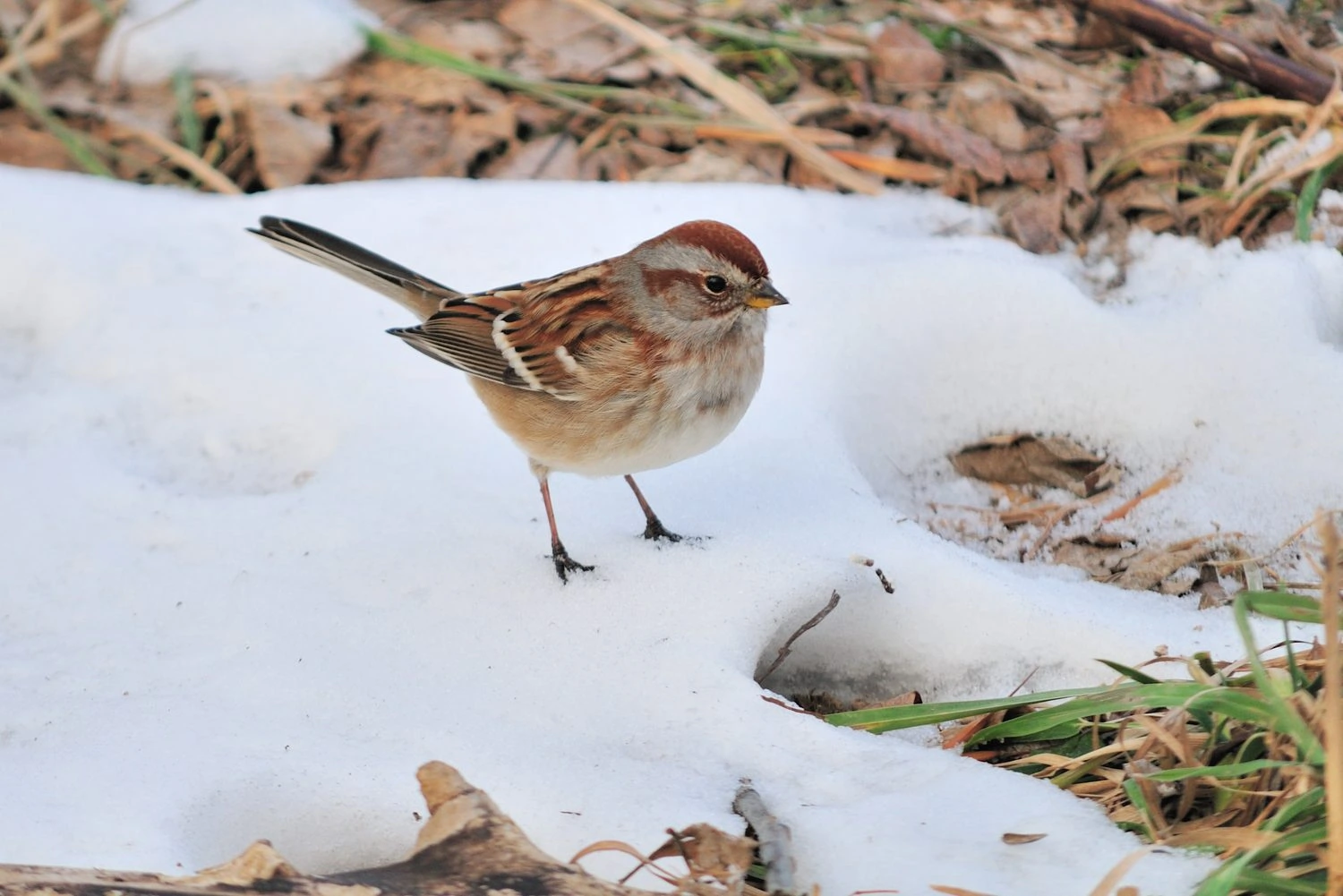
- Spizelloides arborea
- Length: 5.5 in (14 cm)
- Weight: 0.5-1.0 oz (13-28 g)
- Wingspan: 9.4 in (24 cm)
16. Red-breasted Nuthatch
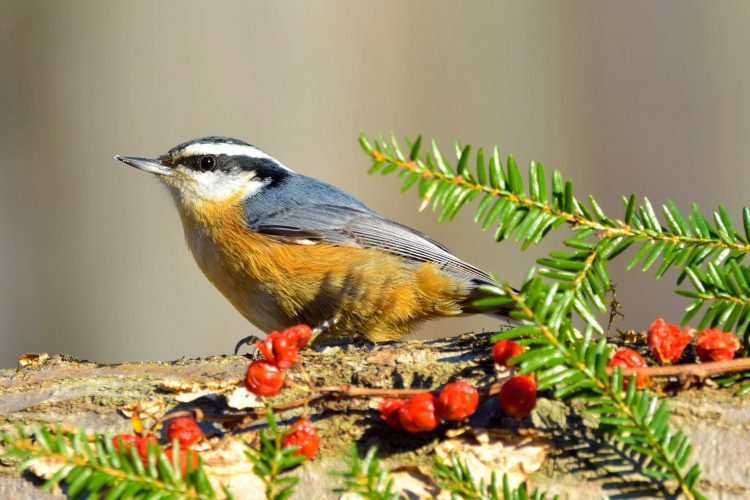
Red-breasted Nuthatches are blue-gray birds with black and white stripes on their heads and a rusty underside.
- Sitta canadensis
- Length: 4.3 in (11 cm)
- Weight: 0.3-0.5 oz (8-13 g)
- Wingspan: 7.1-7.9 in (18-20 cm)
Red-breasted Nuthatches remain all year in northeastern and western states, Alaska and Canada but may move south in winter if cone crops are poor.
You can find Red-breasted Nuthatches in coniferous woods foraging for cones, and they also visit backyard feeders.
Red-breasted Nuthatch Call:
Attract Red-breasted Nuthatches to your backyard with black oil sunflower seeds, suet feeders, peanuts, and mealworms.
17. Common Goldeneye
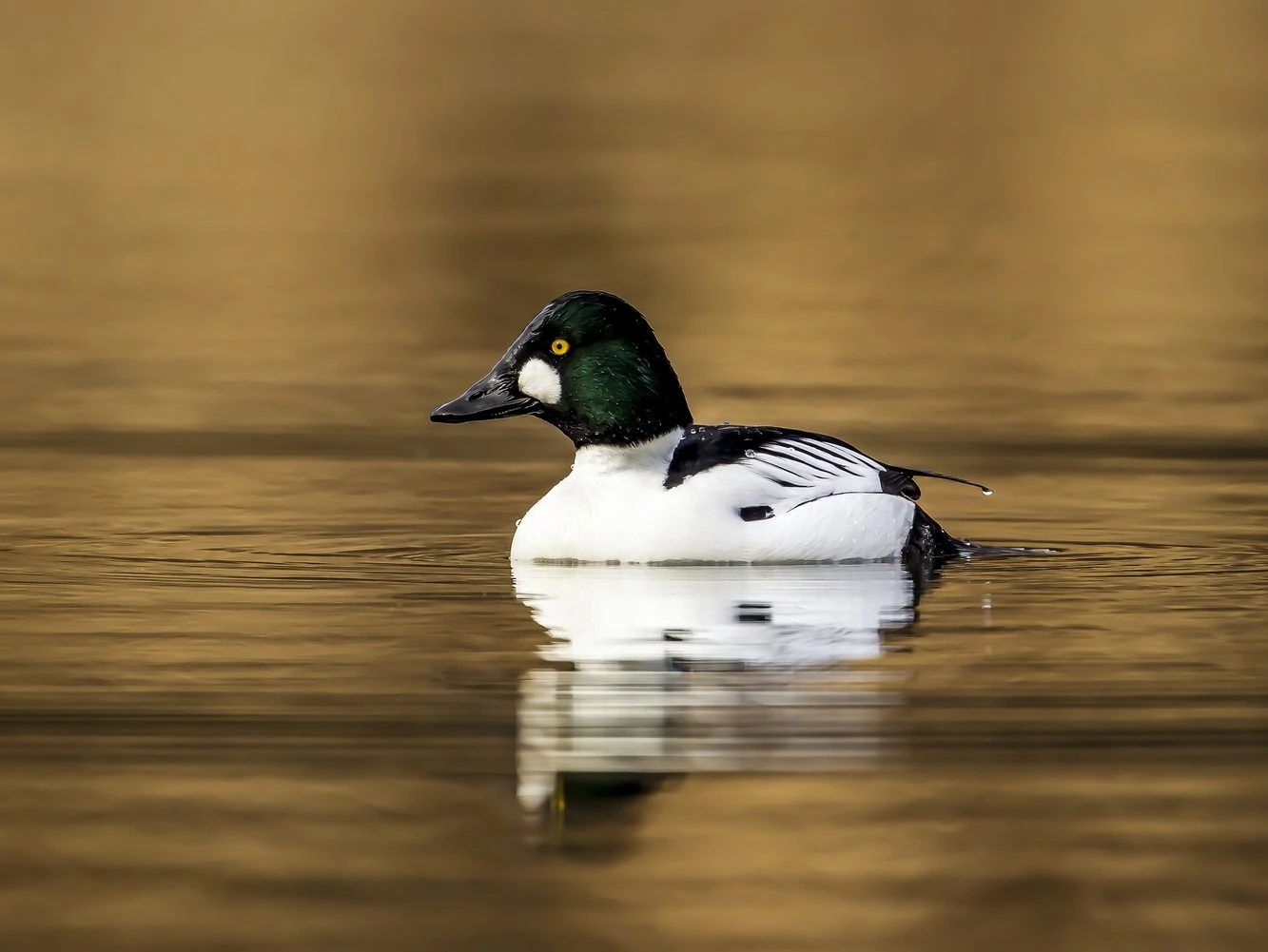
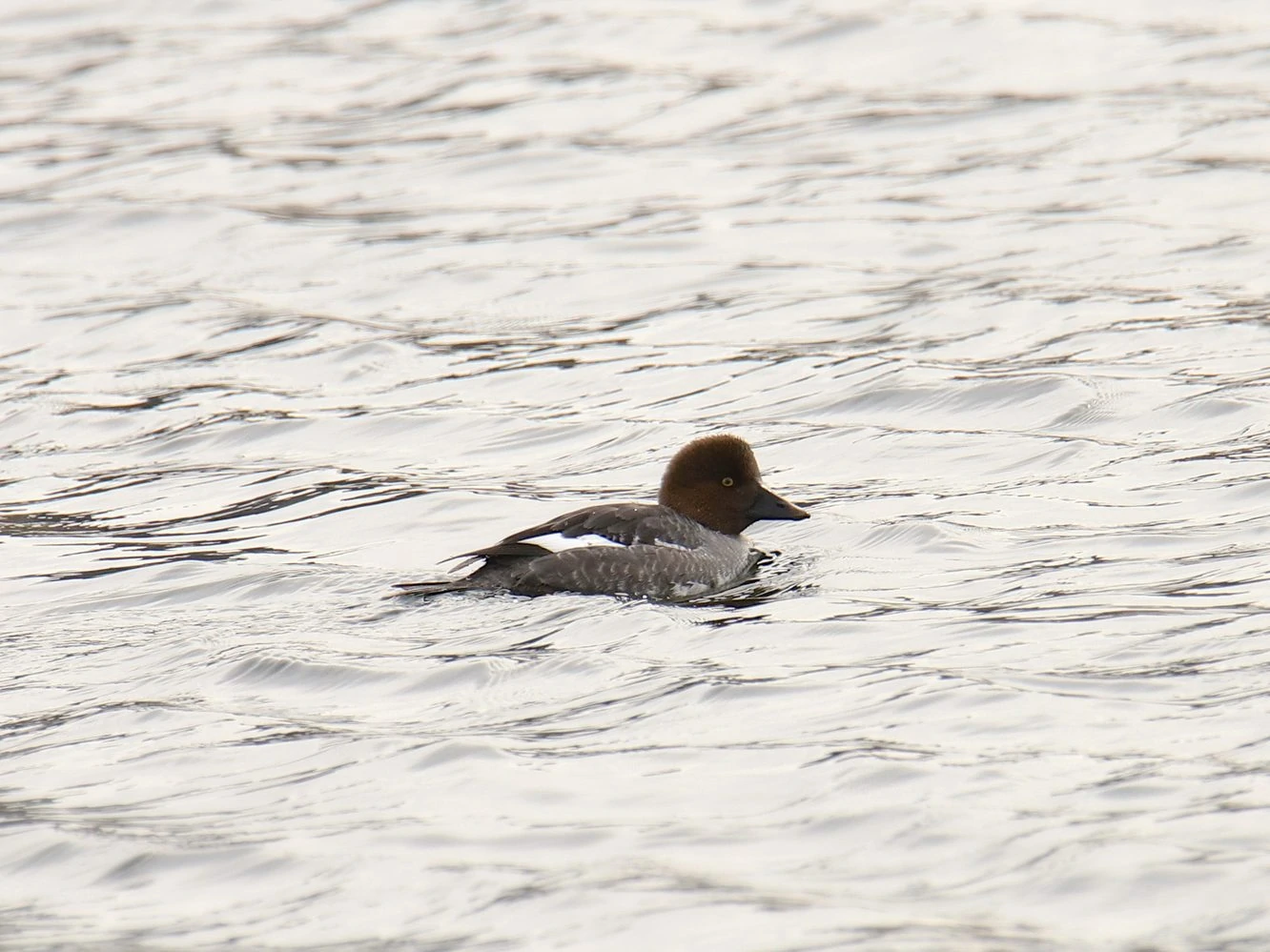
Common Goldeneye males have green heads that are iridescent and can look almost black. They have a white spot under their yellow eyes. They have white bodies and sides and black backs.
Female Common Goldeneyes are grayish-brown with brown heads. Both males and females have black bills, but females have a yellow tip.
- Bucephala clangula
- Length: 15.8 – 20.1 in (40 – 51 cm)
- Weight: 21.2 – 45.9 oz (600 – 1300 g)
- Wingspan: 30.3 – 32.7 in (77 – 83 cm)
Common Goldeneyes breed in Canada and Alaska in summer and migrate late to the lower 48 for winter.
You can find Common Goldeneyes in boreal forest lakes during the breeding season and in coastal areas in winter. Common Goldeneyes are diving ducks that feed on crabs, shrimp, crayfish, fish, fish eggs, and insects.
Common Goldeneye Calls: They are quiet ducks, but male Common Goldeneyes make soft calls, and females make harsh alarm calls.
Common Goldeneye Male
Common Goldeneye Alarm call
Fun Fact: Common Goldeneyes can fly at speeds of over 40 miles per hour.
18. Rock Pigeon
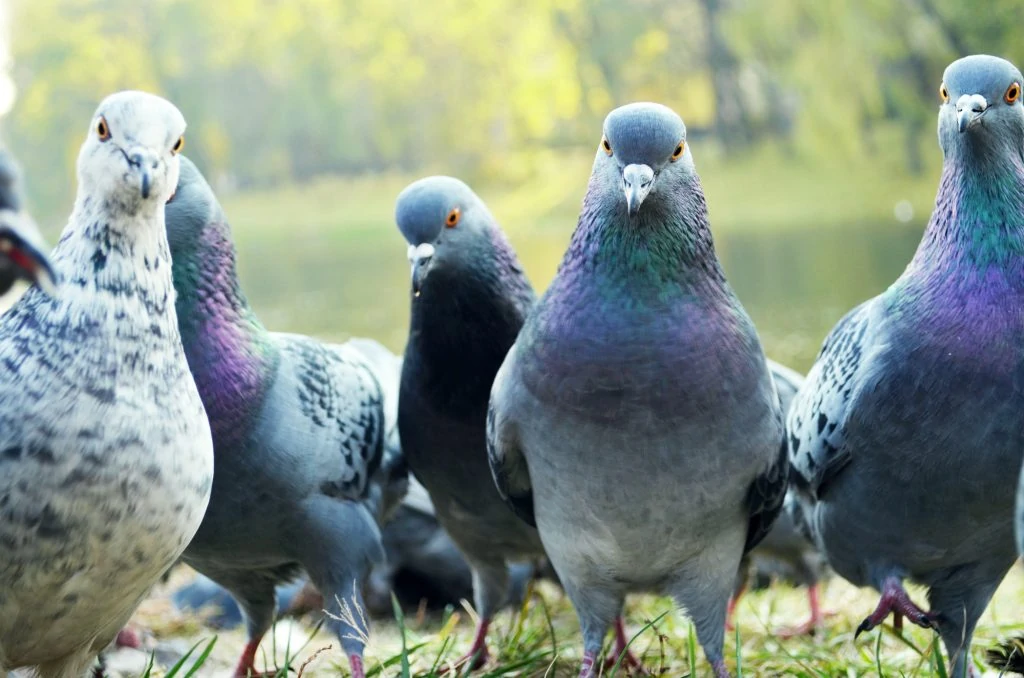
Rock Pigeons are well recognized around towns and parks and are usually blueish gray with two black bands on the wing and black on the tail tip. They have iridescent throat feathers and orange eyes.
However, they can also be white, spotted, or red.
- Columba livia
- Length: 11.8-14.2 in (30-36 cm)
- Weight: 9.3-13.4 oz (265-380 g)
- Wingspan: 19.7-26.4 in (50-67 cm)
Rock Pigeons do not migrate and can be found in all US states, southern Canada, and the Pacific Coast to Alaska.
You can find Rock Pigeons in cities, parks, and backyards, especially if there is birdseed on the ground. Some cities have ordinances against feeding pigeons as they are considered pests.
Rock Pigeon Call:
Fun Fact: Rock Pigeons have an amazing ability to find their way home using the earth’s magnetic field.
19. Herring Gull
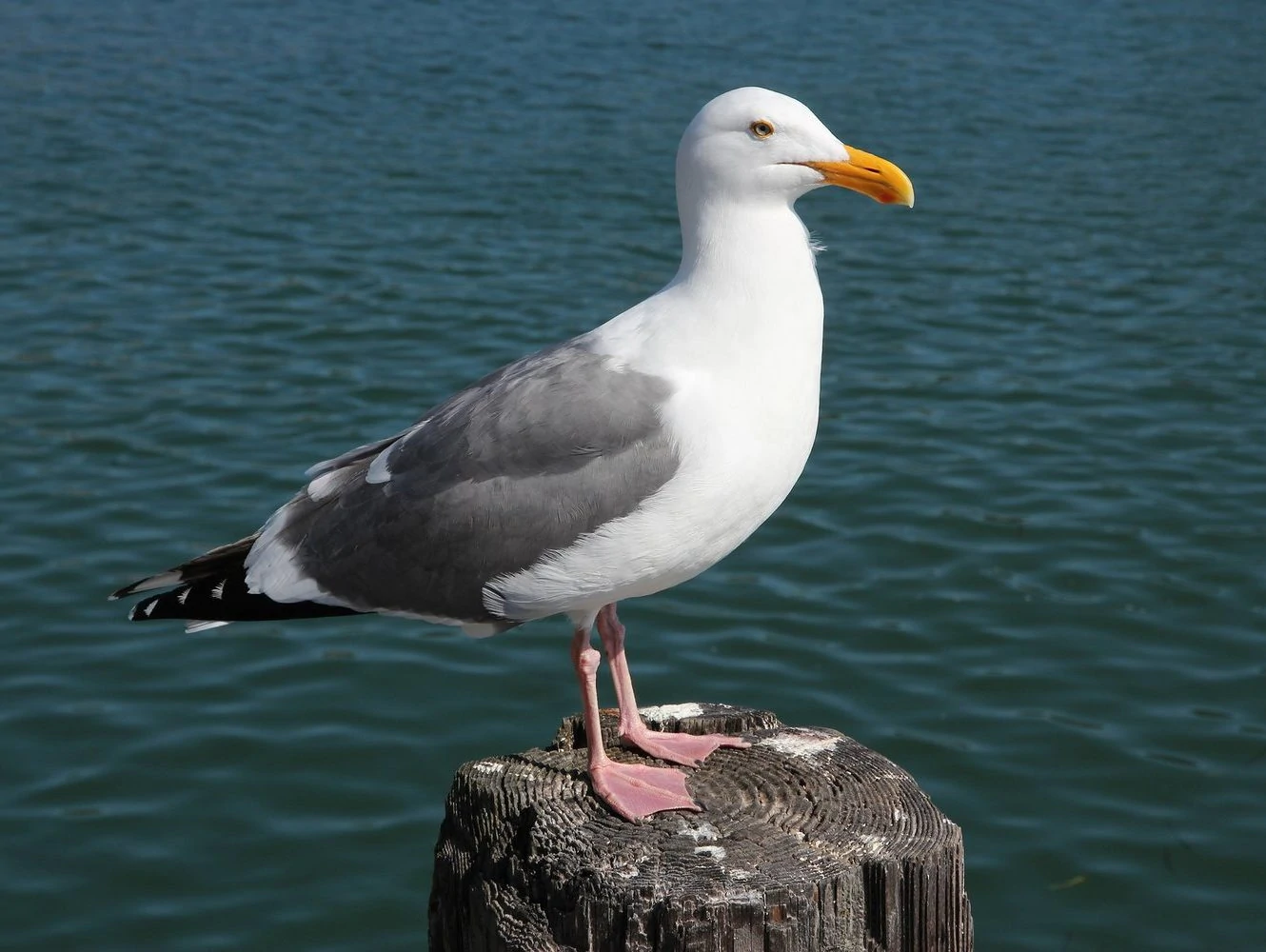
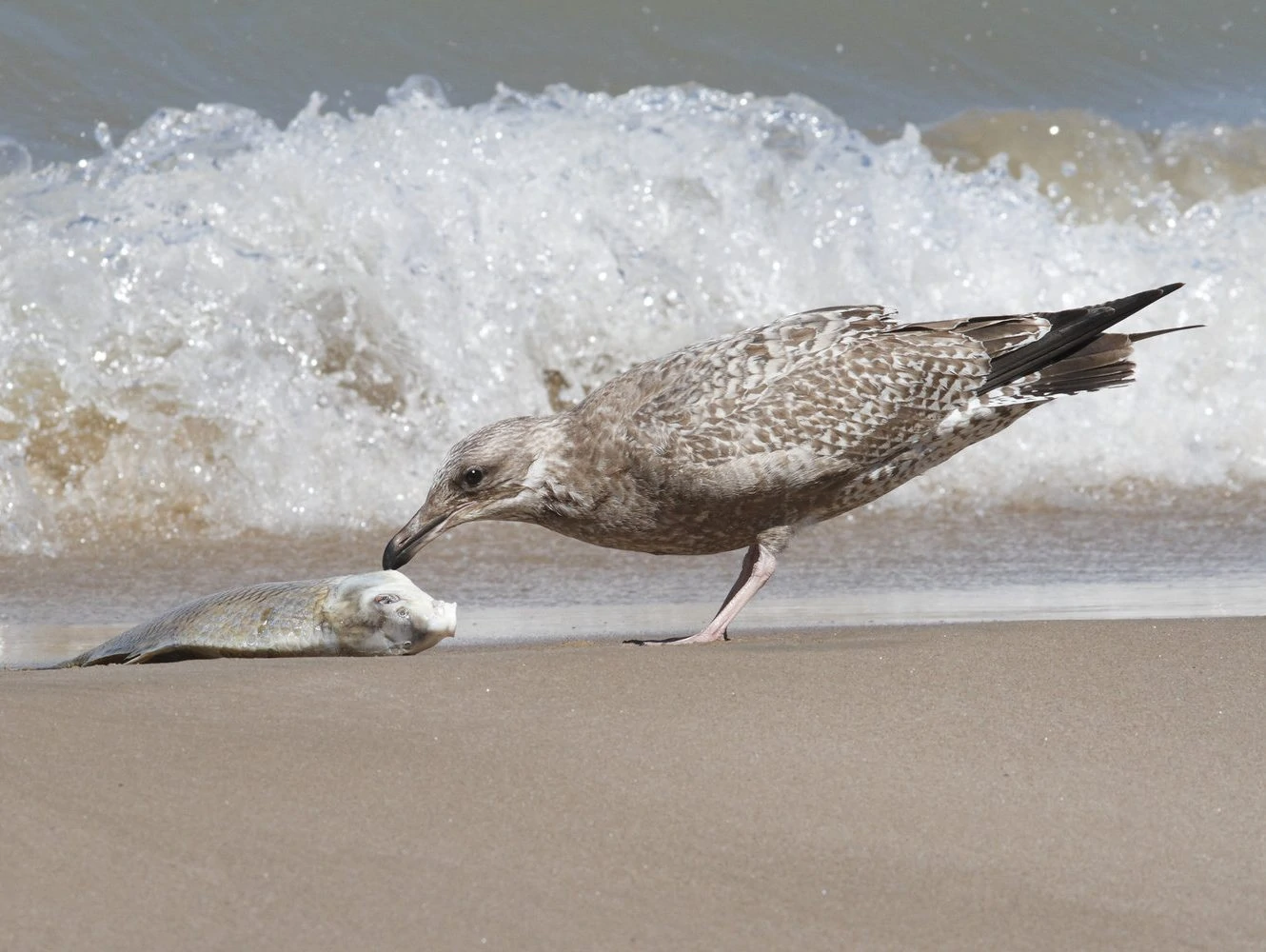
Herring Gulls are the usual ‘seagull’ you will spot, trying their luck to grab your lunch at the beach.
They are generally white with light gray backs and black-tipped wings. Their eyes are yellow with an orange outline. Their bills are also yellow but with a red spot at the tip of the lower mandible. Their legs are short and pink. Both males and females look similar.
Young birds take four years to reach their adult coloring. During their first winter, they are grayish-brown with extensive tan or brown streaking all over their bodies.
- Larus smithsonianus
- Length: 22 – 26 in (56 – 66 cm)
- Weight: 52.9 oz (1499 g)
- Wingspan: 54 – 58 in (137 – 147 cm)
Herring Gulls are found worldwide in the Northern Hemisphere. American Herring Gulls breed predominantly in Canada before migrating to the coasts of Canada and the United States and the Great Lakes and southeastern US states. Some remain all year along the coast and Great Lakes.
You can find Herring Gulls near open water but also at landfills, picnic grounds, and fish-processing plants when they’re foraging for food. Breeding areas include lakes near forests and coastal regions with isolated islands that are safe from ground predators.
Herring gulls are opportunistic feeders and on coastal shorelines, they will feed on mussels, crabs, crayfish, and sea urchins. On mudflats, they will eat worms and clams. In open water, they stay close to large fish and fishing boats that bring smaller fish and squid to the surface.
Herring gulls will even raid the nests of other seabirds to eat the chicks in their nests.
Herring Gull Call:
Fun Fact: Herring gulls are known to drop shellfish on hard surfaces, like rocks or roads, to break them open.
20. Ring-billed Gull
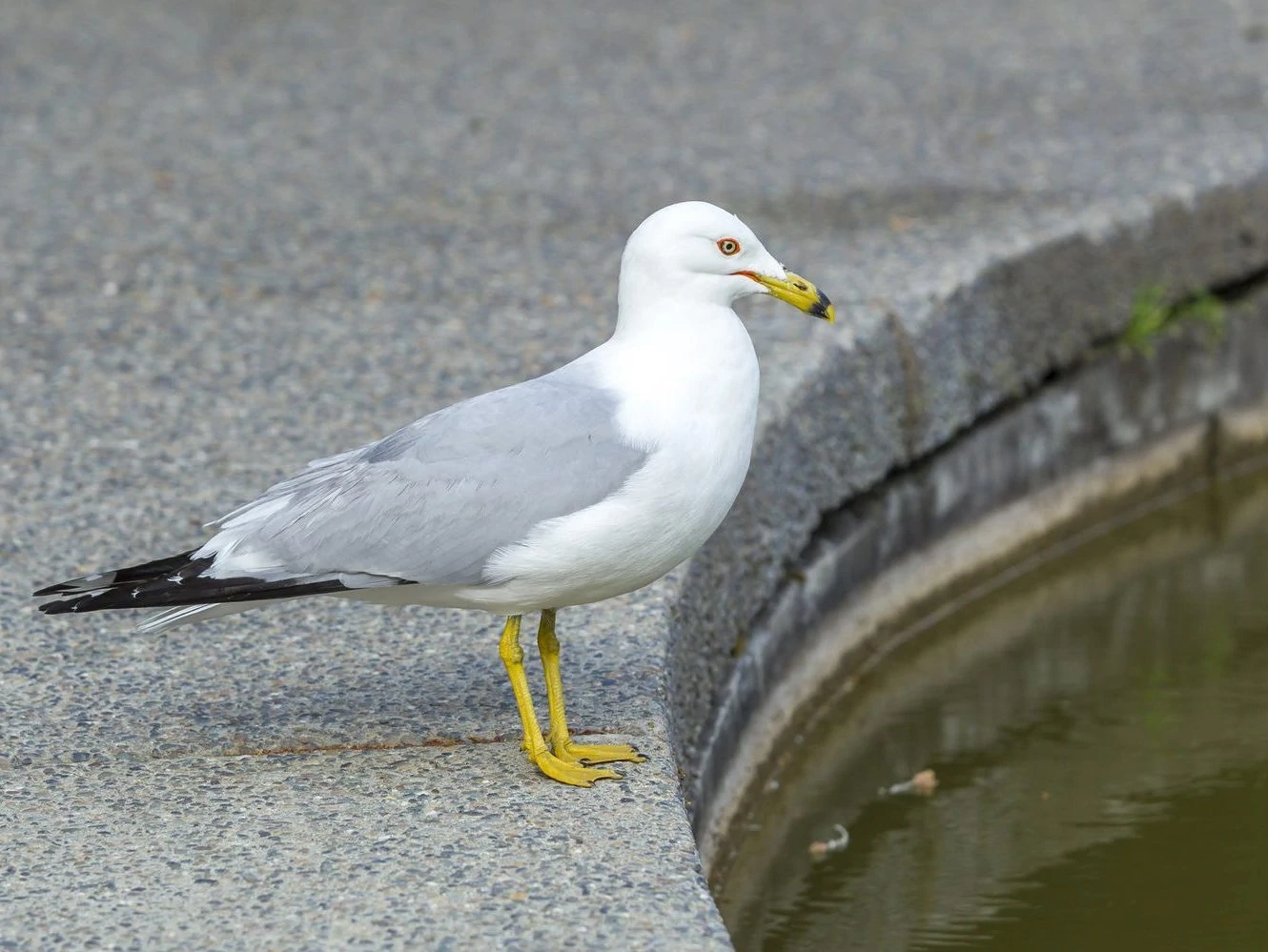
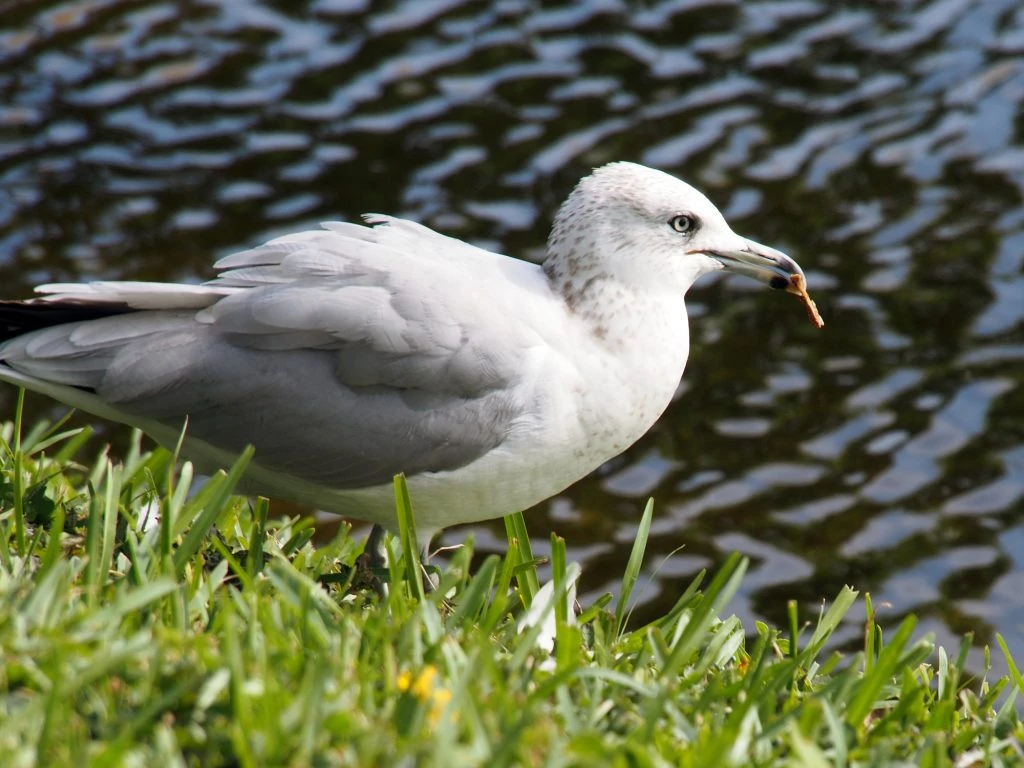
Ring-billed Gulls are medium-sized gulls that are easily identified because of their short, yellow bills with a black ring around them near the tip.
Breeding adults are generally white all-over except for their pale gray backs and wings with black tips and white spots. Their eyes are yellow, outlined with orange. They have yellow legs and feet. Males and females are similar.
The major differences between breeding and non-breeding adults are the light brown streaks on the heads and necks of non-breeding adults.
Juvenile Ring-billed Gulls are covered in brown streaks all over.
- Larus delawarensis
- Length: 18 – 19 in (46 – 48 cm)
- Weight: 20.81 oz (590 g)
- Wingspan: 47 – 48 in (119 – 122 cm)
Ring-billed Gulls breed in Canada and northern and northwestern US states. They migrate for winter to southern US states, the Pacific Coast, and Mexico.
You can find Ring-billed Gulls are comfortable in urban, suburban and agricultural areas, as well as coastal waters, streams, estuaries, and mudflats. They are frequent visitors to parking lots, landfills and reservoirs where they tend to group in large numbers.
Ring-billed Gulls mostly eat fish and insects like bugs, dragonflies, flies, earthworms, and beetles, which they forage from the coastal waters and farm fields. However, they also rummage through garbage for scraps and also capture rodents lurking around these dumpsites.
Ring-billed Gull Call:
Fun Fact: Ring-billed Gulls are sometimes called “fast food gulls” because they often hang out near fast food restaurants and scavenge for food there.
21. Red-tailed Hawk
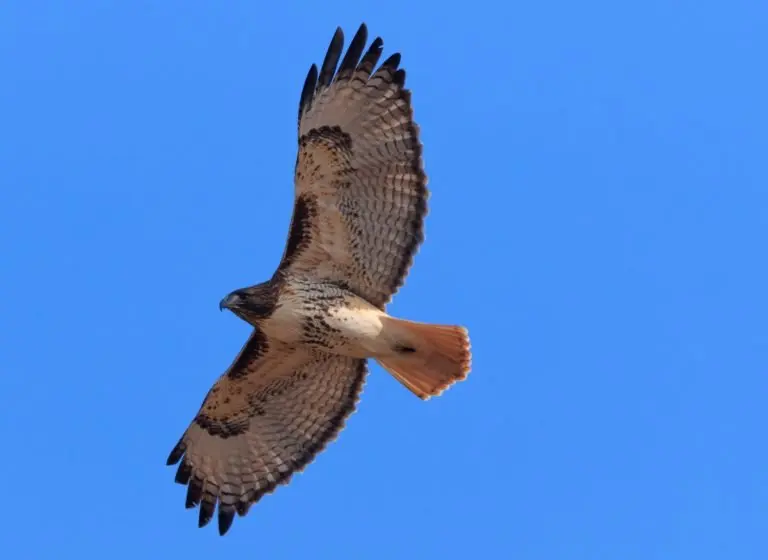
As their name suggests, Red-tailed Hawks have a distinctive short, wide red tail. They are large, with broad, rounded wings. Most Red-tailed Hawks are brown on the back and pale underneath.
They are also the easiest to spot, often on long car journeys, as they circle slowly over open fields looking for prey such as small mammals, birds, and reptiles. You can also see them perched on telephone poles.
Male
- Length: 17.7-22.1 in (45-56 cm)
- Weight: 24.3-45.9 oz (690-1300 g)
- Wingspan: 44.9-52.4 in (114-133 cm)
Female
- Length: 19.7-25.6 in (50-65 cm)
- Weight: 31.8-51.5 oz (900-1460 g)
- Wingspan: 44.9-52.4 in (114-133 cm)
Red-tailed Hawk Call:
The high-pitched descending raspy-screech sound of the Red-tailed Hawk is often used in movies for all birds of prey.
Red-tailed Hawks remain resident in the US and Mexico, but those birds in Alaska, Canada, and the northern Great Plains fly south for winter.
22. House Finch
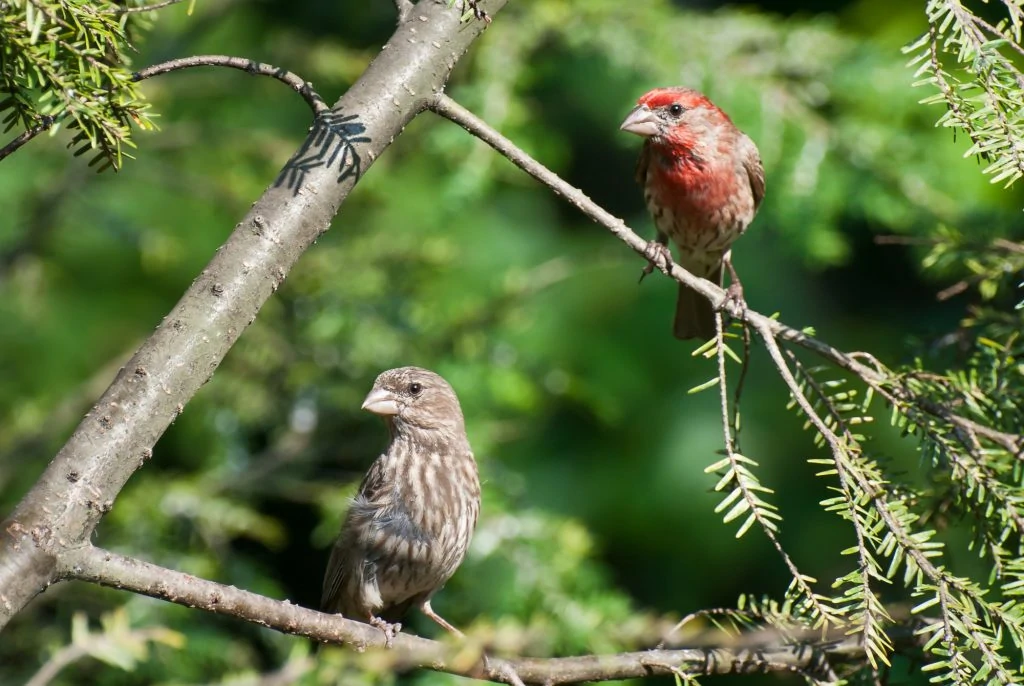
House Finches males have a red head and breast, and the rest of their bodies are mainly brown-streaked. Females are brown-streaked all over.
- Haemorhous mexicanus
- Length: 5.1-5.5 in (13-14 cm)
- Weight: 0.6-0.9 oz (16-27 g)
- Wingspan: 7.9-9.8 in (20-25 cm)
Originally only in western US states, House Finches were introduced to eastern US states and have done very well, even pushing out the Purple Finch.
They can be found in parks, farms, forest edges, and backyard feeders in noisy groups that are hard to miss.
House Finch Song:
House Finch Call:
Attract House Finches to backyard feeders with black oil sunflower seeds or nyjer seeds in tube feeders or platform feeders.
23. Common Raven
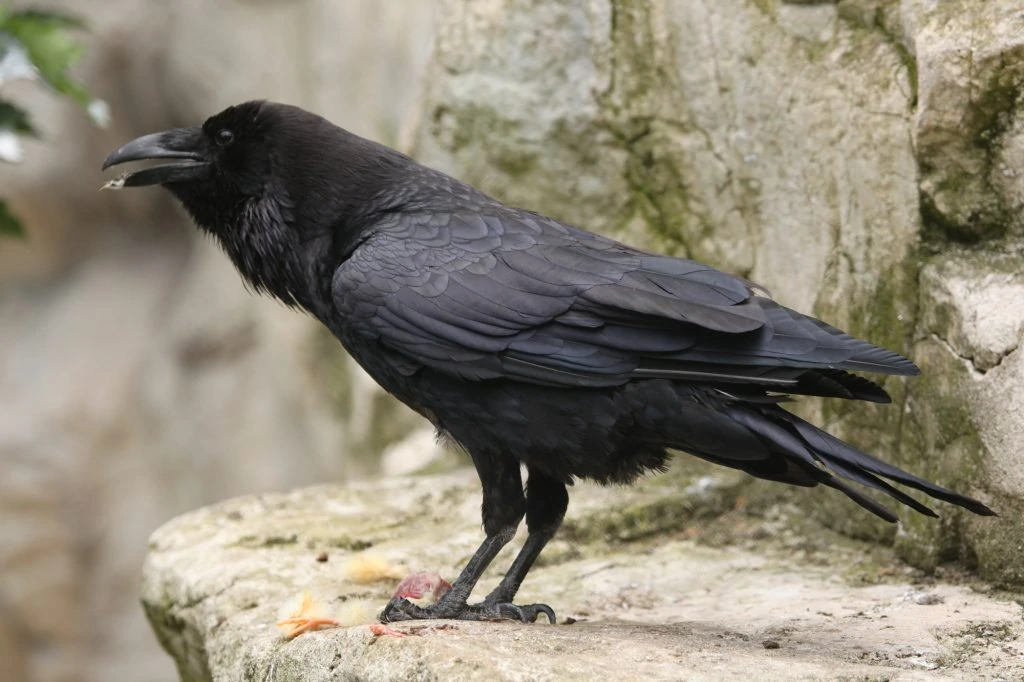
Common Ravens are thought to be one of the smartest and definitely one of the largest species in the songbird family. They have shaggy throat feathers, large black beaks, and wedge-shaped tails.
- Corvus corax
- Length: 22.1-27.2 in (56-69 cm)
- Weight: 24.3-57.3 oz (689-1625 g)
- Wingspan: 45.7-46.5 in (116-118 cm)
Common Ravens are resident in Canada, western US states, northeastern US states, Mexico, and northern Central America. They are not found in the Great Plains or eastern US states.
You can find Common Ravens in most places, and they especially follow humans. Forests, beaches, fields, grasslands are all places to find them and rural human areas. They are not common in towns and cities as American Crows take over.
Not known as picky eaters, Common Ravens will eat most things, including any small animals, eggs and nestlings, plus insects and fish. Human rubbish and pet food
Common Raven sounds: Mostly croaks and harsh calls
Fun Fact: Common Ravens in Canada weigh up to 60% more than those in California.
24. Common Merganser
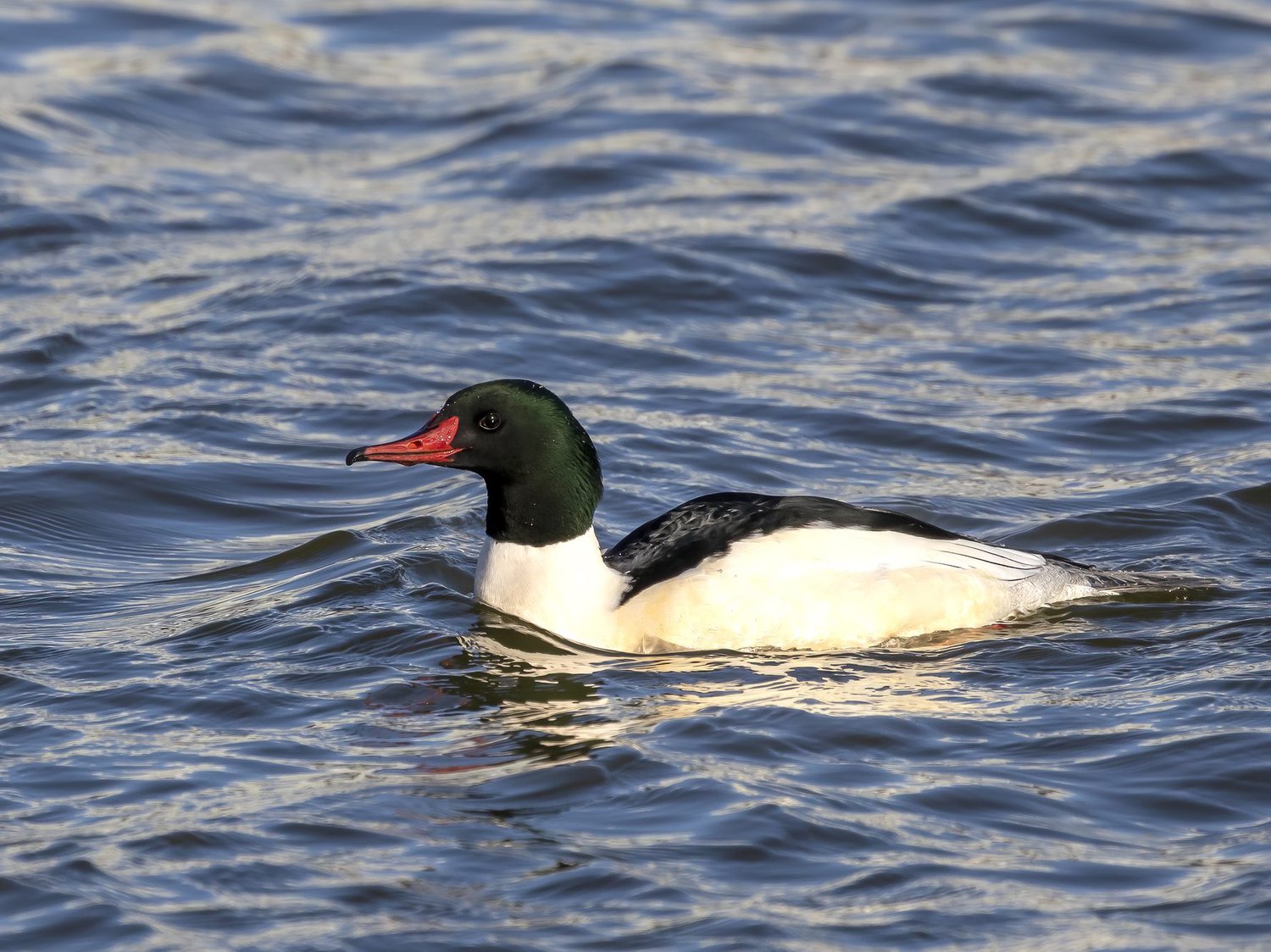
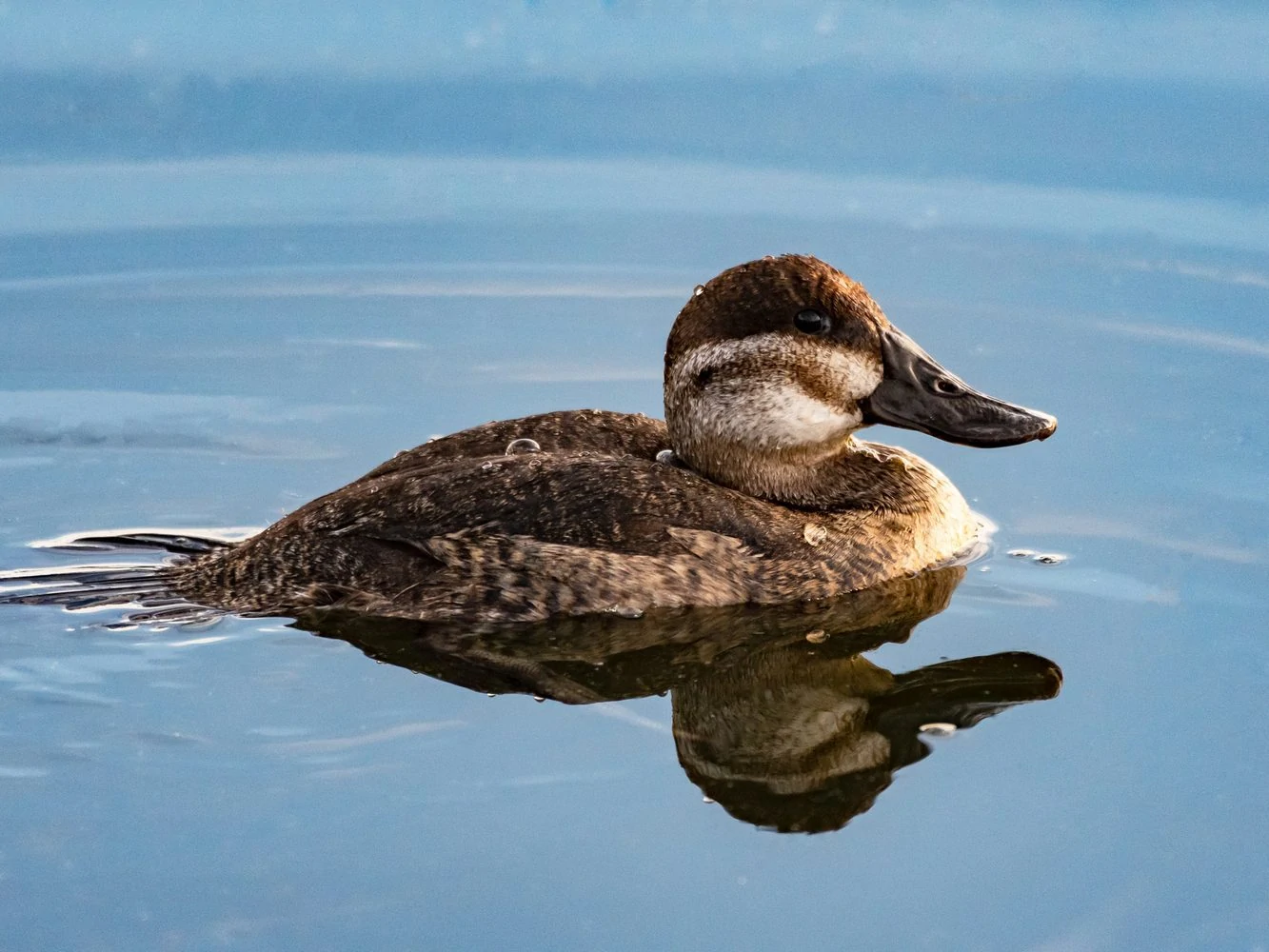
Male Common Mergansers are simple-patterned birds but striking nonetheless. They have black heads with a glossy green sheen, dark eyes, bright-red, long, serrated bills, white bodies, and black backs. While they do have a crest, it’s not often visible.
Females have a more prominent reddish-brown crest. They have the same red, serrated bill as the males. They also have a white chin patch, and their breast and bellies are white, their backs are gray. Juveniles resemble females.
- Mergus merganser
- Length: 22 – 27 in (56 – 69 cm)
- Weight: 60.8 oz (1723 g)
- Wingspan: 31 – 37 in (79 – 94 cm)
Common Mergansers breed in Canada and migrate to the US. Some remain all year in northeastern and northwestern US states.
You can find Common Mergansers in freshwater lakes and ponds. They are also found in small rivers and shallow shorelines and even sitting on rocks in the middle of a stream. While they prefer freshwater habitats, they sometimes visit saltwater regions too, like coastal estuaries and harbors.
Common Mergansers are diving ducks, and they love to eat fish, particularly the adults. Their serrated bills make it easy for them to capture and hold these fish as well as mussels, crustaceans, and other aquatic creatures. Gulls often follow them when hunting to steal the fish from them.
Common Merganser Calls: They are usually fairly quiet, but Male Common Mergansers give alarm calls, and females make a series of grunting calls to their young.
Male Common Merganser call
Female Common Merganser call
Fun Fact: Common Mergansers are also called “sawbills,” “fish ducks,” or “goosanders.”
25. American Robin
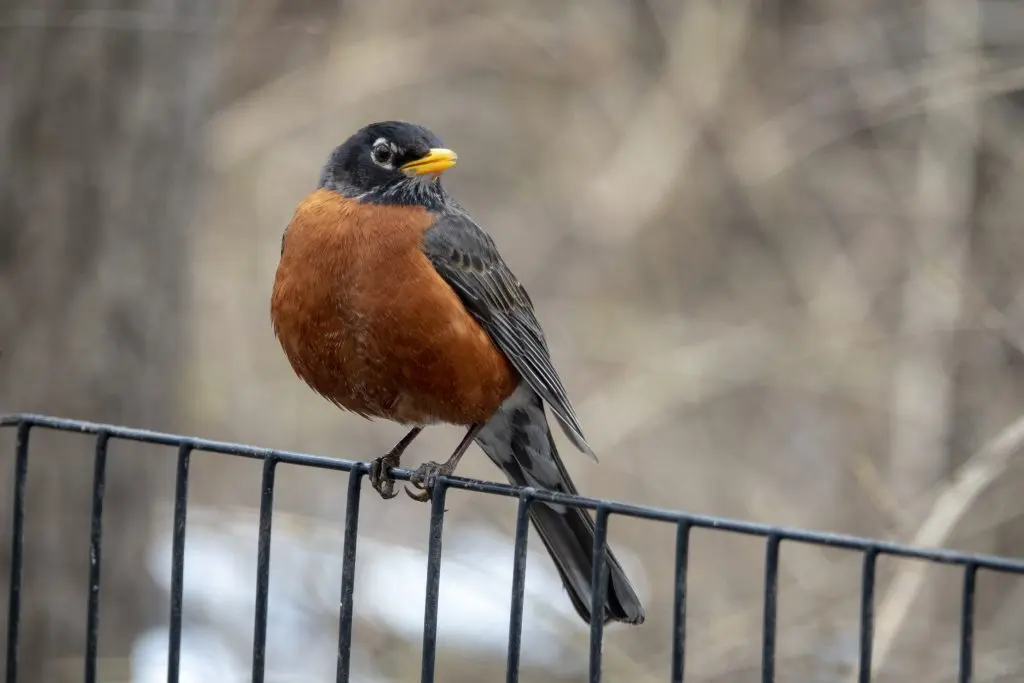
American Robins are a common sight on lawns eating earthworms. They have black heads and backs with red or orange breasts. They tend to roost in trees in winter, so you are more likely to see them in your backyard from spring.
- Turdus migratorius
- Length: 7.9-11.0 in (20-28 cm)
- Weight: 2.7-3.0 oz (77-85 g)
- Wingspan: 12.2-15.8 in (31-40 cm)
American Robins are residents in the lower 48 and the coast of Western Canada and Alaska. Those that breed in Canada and inland Alaska move south for the winter.
American Robins can be found in many habitats, from woodlands, forests, and mountains to fields, parks, and lawns. They eat earthworms, insects, snails, and fruit.
American Robin Song:
American Robin Call:
Attract American Robins to your backyard with sunflower seeds, suet and peanut hearts, fruit, and mealworms. Platform feeders are best or food scattered on the ground. Also, try planting some native plants that produce berries, such as juniper, sumac, hawthorn, and dogwood.
Winter vs Summer Birds Ontario
There are some birds that stay all year in Ontario but many migrate in or out in the spring and fall. These lists give you the most common birds recorded in checklists by bird watchers in summer or winter on ebird.
Winter Birds Ontario:
Black-capped Chickadee 54.14%
Dark-eyed Junco 33.35%
Blue Jay 32.78%
American Crow 32.31%
Northern Cardinal 32.25%
Downy Woodpecker 31.75%
American Goldfinch 27.86%
Mourning Dove 27.84%
White-breasted Nuthatch 27.30%
Canada Goose 22.28%
Mallard 21.85%
European Starling 21.30%
House Sparrow 20.55%
Hairy Woodpecker 18.54%
American Tree Sparrow 17.52%
Summer Birds Ontario:
American Robin 55.19%
Song Sparrow 47.57%
American Goldfinch 46.37%
Red-winged Blackbird 40.73%
American Crow 38.47%
Common Grackle 37.06%
Black-capped Chickadee 36.44%
Mourning Dove 35.35%
Blue Jay 35.04%
Red-eyed Vireo 32.55%
Northern Cardinal 29.35%
European Starling 28.88%
Ring-billed Gull 27.71%
Cedar Waxwing 26.60%
Mallard 23.31%

